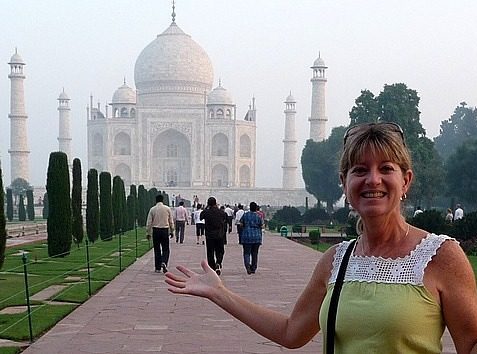Today we were off on a 2 hour drive to the historic city of Malacca, once a great sea port in Malaysia. Joel picked me up at 6:30 a.m. (to avoid traffic) and the drive to Malacca turned out to be pretty much uneventful as most of the driving was on a very nice three lane highway, although we frequently had to avoid the dodging motorcycles. They are everywhere and have little regard for anyone else on the freeway. Quite frankly, I am surprised I have not run into motorcycle accident.

Anyway, we pulled into Malacca just after 8:30 a.m., found a parking spot and proceeded to walk past remnants of the original Portuguese fort (later taken over and run by the Dutch) before taking the path along the Malacca River past beautiful old multi-coloured houses that had been converted into shops, restaurants and bars. Apparently this is a happening place in the evening.
 At one point as we walked along, Joel spotted an iguana swimming in the river. There is apparently a family of iguanas that inhabit this portion of the river and as we neared the area where it was swimming the iguana lifted itself out of the water so I was able to take a really cool picture.
At one point as we walked along, Joel spotted an iguana swimming in the river. There is apparently a family of iguanas that inhabit this portion of the river and as we neared the area where it was swimming the iguana lifted itself out of the water so I was able to take a really cool picture.

After a 15 minute walk, we reached the Stadthuys, aka Red Square, nicknamed such because the buildings, including the Stadthuys (city hall) and Christ Church Malacca were painted bright red.
The Dutch built the Stadthuys in the 1650s when they took over Malacca after defeating the Portuguese in 1641. The building was used by the Dutch as an administrative center and governor’s residence and when the British took over they continued to use the building as administrative center as well.
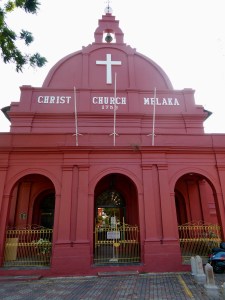
And adjacent to the Stadthuys was Christ Church Malacca, the oldest Protestant church built by the Dutch in 1753. (The Church was apparently originally painted white, but was repainted red in 1911 to match the Stadthuys.
We took a walk through Christ Church Malacca to admire the original old wooden pews and doors. I was amused to see a stone placard on the wall commemorating the passing of a Dutch man’s wife who commissioned the stone placard “as a fmall (small?) Mark of his Regard For an amiable and affectionate Wife”. Quite the high praise.

Anyway, once we took a walk through the church, we walked past the Stadthuys and up the stairs towards St. Paul’s Hill (named such for the old St. Paul’s Church at the top of the hill).
Our walk took us past an old Dutch well and a fire engine first used in Malacca in 1939 and ended its service in 1973. Quite the run.


Now, although we had not reached the top of the hill, the views were still pretty good as we were able to take in more remains of the Portuguese/Dutch fort and a myriad of old Dutch and British homes. We climbed up one more staircase before reaching the top of St. Paul’s Hill and the remains of the St. Paul Church.

The old stone church was originally constructed by the Portuguese and originally called The Annunciation Church. When the Dutch took over from the Portuguese in1641, the church became known as Bovenkerk (Church on the Hill), and of course, when the Brits took over in 1824 the church became know as St. Paul’s Church.


The stone walls of the church remain along with numerous old Dutch graves with the odd Portuguese and British grave here and there. The oldest grave dated to 1545 and appeared to be a Portuguese man by the name of Dom Miguel de Castro and the most recent grave dated to 1841 and appeared to be a British woman named Jane Charlotte Westerhaus. The remainder of the graves were Dutch graves (save for one more Portuguese grave) from the 17thcentury. I found it curious that there was only one single British grave here and wondered why they buried her here.
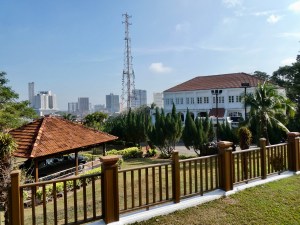
Anyway, we walked out the back of the church and took a quick Look at the last British governor’s residence, which was adjacent to the church, before walking down a series of steps to the Porta De Santiago (Santiago Gate), which was one of the four main gateways into the Portuguese fortress of A Famosa.

Now the Portuguese originally constructed the fortress in 1511 in order to defend against frequent attacks from the followers of Sultan Madmud Shah and invaders from neighboring islands. The fortress was taken over by the Dutch in 1641 after they defeated the Portuguese, but sadly, the majority of the fortress was destroyed when the British defeated the Dutch in 1824. It really is quite sad because the fortress must have been absolutely amazing given just how far the walls spanned. Everywhere we walked, we seemed to run into ruins from the fortress walls. Pretty darn impressive.

And I came to learn that the area that we ended up in near the Porta De Santiago is also historic in its own right for its importance in Malaysian Independence. It turns out that an area across from Porta De Santiago known as Padang Banda Hilir is the spot where YTM Tunku Abdul Rahman Putra proclaimed Malaysia’s independence from Britain in February 1956. There was a triangle marking the spot with the date August 31, 1957, which was the date the British handed over the reigns to the Malaysians in Independence Square in Kuala Lumpur.

Right beside the marker was yet more remains for the Portuguese fortress known as the Santiago Bastion, which Porta De Santiago was part of. These walls were only discovered in 2002 during excavation work and marked the original shoreline of the Straights of Malacca.

And if you wanted to know know about the history of Malaysia’s independence there was an entire building, Proclamation of Independence Museum, across from the site where independence was declared where you could go and peruse to your heart’s content.

On the backside of the Proclamation of Independence Museum was the renovated Malacca Sultanate Palace, which Joel said was nothing more than a tourist trap so we did not even bother to walk to the site.

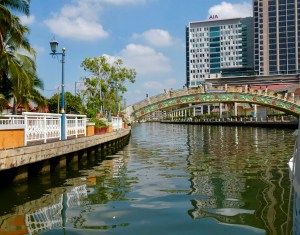

By now, we had been walking for 2 hours so we headed back to the Malacca River where I was going to take a cruise. The river cruise turned out to be a nice respite from the heat and humidity (although every now and then I would catch a whiff of the river, which was not particularly nice).
The river cruise took me past the multicoloured buildings we had walked by earlier, (no iguanas spotted) and under bridge overpasses decorated in Chinese, Hindu and Malay designs. And like the buildings in Kuala Lumpur, there was a lot of art work covering the buildings featuring local people going about every day life.

And just before we turned around to head back to the dock, we passed an area known as Kampong Morton, which featured an entire area of old Chinese houses. Many of the homes appear to have been refurbished and the garden areas were beautiful with “azaleas in full bloom” (Masters reference).
Just after we passed Kampong Morton, the boat made a u-turn and headed back in the same direction from which we came. Once at the dock, Joel and I walked back near to our original starting point, before crossing a bridge and taking a stroll down Jonker Walk, a street in the Chinatown district filled with shops and restaurants.

We ended up stopping for a bite to eat at a restaurant that appeared to be a local franchise serving Indian dishes as the scrolling sign above the cash register listed numerous locations. Now lunch was OK, pandan rice, chicken and nuts, but the star was the lemon grass juice. Spectacular. Not very sweet, but incredibly refreshing.

Our last official stop of the day was a spectacular Chinese mansion turned museum known as Baba & Nonya Heritage Museum. Baba was Chinese and married Nonya, a Malay woman, and they lived, by all accounts, an incredibly lavish lifestyle built on the backs of rubber tree plants. Four generations lived in the home until it was converted into a museum in 1985.



The décor was vintage Chinese with lots of blue and white pottery, paintings featuring Chinese cranes, Chinese royalty and Chinese military scenes. There was a lot of dark wood, but the courtyard in the middle of house featured bright yellow colours, which really made the room my favorite.
Anyway, after the once around, Joel and I walked back to the car stopping once at a pastry shop so Joel could buy me some of that ultra sweet coconut/palm sugared desert I had a couple days ago (didn’t have the heart to tell him I did not like it), before getting in the car and heading out of town.

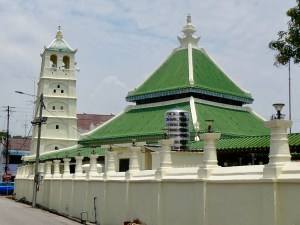
We made two more stops along the way. The first stop was so I could take a look at Chen Hoon Teng Temple, aka Green Clouds Temple, built in 1673 and still in use to this day. The temple was dedicated to Kwan Yin, the Goddess of Mercy and combines Buddhism, Confucianism and Taoism just like the Thean Hou Temple I visited in Kuala Lumpur. And at Joel’s suggestion, I wandered down the street and took a look at the Kampong Kling Mosque, which combined Chinese, Malay and Indian designs into the building. Again, another really unique mosque.

And as we left the city limits of Malacca, we made a quick stop by the side of the road so I could see the Al-Azim Malacca Mosque, which is the official mosque of the state of Malacca having been opened in 1990.
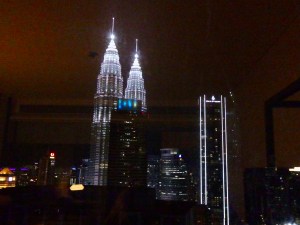

So after the last stop, we made our way to the freeway and back to Kuala Lumpur. Fortunately, we beat the traffic and Joel and I were back at my hotel in just about 2 ½ hours. I said my goodbyes to Joel and headed upstairs to pack for my flight to Brunei tomorrow. I was so tired, I skipped dinner and opted instead to watch the light show (Petronas Towers and dancing fountains) from my room window and then turned in early. Tomorrow was a quick 2 hour flight to Brunei and then my 2 week adventure in Borneo begins.
